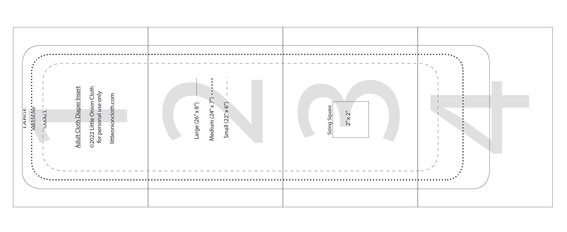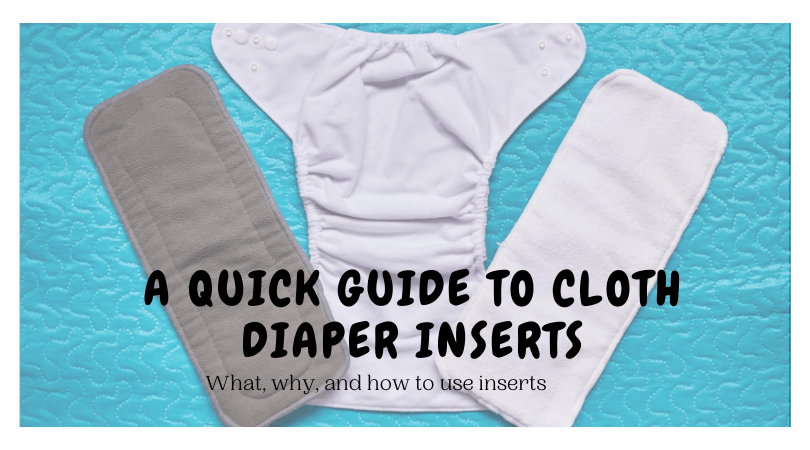Cloth diaper inserts aren’t just for babies. These puppies can revolutionize your cloth diapering experience no matter what age or size you are diapering for. While the selection of inserts for older children and adults are far fewer, Etsy and other adult diaper companies have some options. Also, many baby products can double as inserts for bigger sizes. (More on that in another post).
So. Insert, soaker, booster, doubler. All these terms essentially refer to the removable absorbent layers in a cloth diaper. Inserts can be:
- stuffed in a pocket
- snapped in
- tucked under a flap
- simply laid in
These items are made from a variety of materials including natural fibers like cotton, bamboo, and hemp or synthetic man-made material like microfiber. While “insert” is often used as a blanket term to describe the absorbent layers, there are several terms used to describe different products. However, “insert” and “soaker” are actually the same thing! I posed this question to a major baby diaper manufacturer and they confirmed it.
That said, typing in “insert” vs. “soaker” online will yield vastly different search results — so be careful!
These differences are outlined in the below definitions.
Insert
A diaper insert is the absorbent padding that goes inside of pocket diapers or anything that gets laid in a cover as an absorbing layer.
- For pocket diapers, these inserts are most often made from the fast absorbing fabric microfiber. Microfiber cannot be used next to skin, which makes it optimal for pockets.
- Other inserts are made from natural fiber like bamboo, cotton, hemp, and blends of those fabrics.
- Prefolds and flats can often be found categorized under “insert.”
Soaker Pad
On the other hand, the soaker is the absorbent padding that snaps in. It’s also a sewn-in flap in an All-in-2 (AI2), All-in-One (AIO), or fitted diaper.
Basically, if it has snaps or it’s a sewn-in flap, it’s generally called a soaker.
Soakers:
- Are most often made from natural fabrics like those listed for inserts.
- Can sometimes be made from synthetic materials, which are sandwiched between natural fibers.
- Can be made from disposable materials designed for a one time use.
Booster/Doubler
“Booster” or “doubler” is basically a way of adding more absorbency to a cloth diaper, aka to “boost” or “double” a cloth diaper’s absorbency.
It’s important to select a doubler that won’t add bulk around the legs because that could affect the fit and cause leaks. Choosing a booster with a stay-dry top, such as microfleece, can help protect the skin from moisture if the diaper will be worn for a while.
Boosters:
- Are typically made from 2-4 layers of fabric.
- Are usually smaller than an insert, either rectangular or hourglass in shape.
- Can be added to any cloth diaper.
- A great way to add absorbency without increasing drying time or bulk.
Liner
A liner wicks moisture away from the skin, minimizes staining, and helps make disposal of solids easier.
Liners can be either disposable or reusable. If rash cream is used, liners protect the diaper by adding a barrier because rash cream can build up and cause diapers to repel moisture. So note that while some diaper creams claim to be diaper safe, it’s always best to use a liner when applying diaper cream.
- Disposable: A disposable (also called flushable) liner is made from 100% natural fibers, such as bamboo, and woven into a very thin fabric-like sheet. The liner is then placed on the top of the inside of the diaper so that it rests against the skin. It is used to catch solids, which are then disposed of by flushing down the toilet. Just note that most flushable liners are not recommended for septic systems.
- Fabric: Fabric liners are most commonly made from polyester microfleece, though they can also be bamboo or silk. In addition to making diaper changes easier and reducing stains, microfleece liners can also protect the wearer from feeling the wetness of the cloth diaper, as its job is to wick moisture from the skin to the absorbent layers of the diaper.
Styles of Inserts
Inserts come in all shapes, sizes, and fabric types. The ones you ultimately choose to use will depend on your budget, needs, and how much work you want to put into using them.
Pad
A pad is simply multiple layers of fabric (usually 4-6) sewn into a thick rectangular shaped pad.
This is the most common insert style. Type “insert” into google or any cloth diaper store and chances are, most of the results will be shaped like this. Pad shaped inserts are easy to use and fit into any diaper. Boosters are most commonly pad shaped.
How to use: stuff it in a pocket diaper, place in a diaper cover or in any diaper style for extra absorbency.

Flat
As we covered in 14 Types of Cloth Diaper,” a flat is a very large single layer of fabric. Most often made of cotton, many baby manufacturers also make them in bamboo and hemp.
How to use: While there are a myriad of ways to wrap a folded flat around the body, when using as an insert, simply fold in half several times to reach your desired size and then stuff into a pocket diaper or lay in a cover.
Prefold
Again, a prefold is a rectangular shaped diaper that has been folded multiple times with the most amount of absorbent layers concentrated in the middle third of the diaper and then sewn down.
How to use: Like the flat, there is a ton of information and tutorials covering how to fold a prefold. However, to use as an insert, fold the thinner side flaps over the center in a tidy trifold. Then, stuff into a pocket diaper or lay in a cover.
Trifold
A trifold is made up of two to three equal size rectangular layers of fabric sewn together around the outside edge.
This is unlike the prefold, as prefolds are made up of more layers with most the layers folded and sewn down the middle. Called a trifold because it’s meant to be folded into thirds to create a pad-shaped insert, you get more fabric layers and less drying time. Some come with a layer of stay-dry fabric. These are commonly made from bamboo fleece or jersey.
How to use: Fold the short direction to get a shorter insert or fold the long way to get a longer insert. Like the prefold, simply fold the insert into thirds and stuff into a pocket, lay flat in a cover.

Snake
A snake style soaker is 2-3 layers of fabric in a very long snake-like strip.
These most often come as a snap-in part of some brands of diapers. They are not very common and are even harder to find if you just want to buy a snake soaker by itself, although you can find them in most materials on Etsy and some diaper stores.
How to use: A snake style soaker can be folded in half and put into a diaper, or one end can be folded onto itself like an accordian to concentrate absorbency at the front or back of a diaper.
Contour
A contour insert is in the shape of an hourglass.
Like the pad, it has 4-6 layers of fabric. The hourglass shape is designed to put extra absorbency at the front and back while decreasing bulk between the legs. While the pad shaped inserts are the most common, you can easily find contour-shaped inserts in different fabrics.
How to Use: Simply place into cover, stuff into a pocket or inside your diaper of choice.

Petal
A petal insert is made from two or more thin inserts sewn together or snapped at one end, allowing for quicker drying.
Can be contour or pad shaped. This style of insert is not very common, but it tackles the balancing act of absorbency vs. drying time. You get the multiple layers of an insert, but since those layers are divided between 2 inserts, drying time is significantly less. With the inserts attached at the top, you can avoid any uncomfortable shifting.
How to Use: stuff in a pocket diaper, lay in a cover, or add on top of any diaper for a doubler.


3 Rules of Thumb for Creating Absorbent Diaper Insert Combinations
The lighthearted diaper rainbow illustration above shows how cloth diaper inserts work together to move liquid and keep skin dry.
1. Liner (against the skin)
2. Fast absorbing (middle)
3. Hold (outer)
1. Liner
It’s true, liners are optional — you don’t need an extra layer between the skin and the diaper unless you’re using microfiber inserts. But liners are incredibly helpful. They protect the skin and make disposal of solids MUCH easier. If you’ve ever tried to shake a diaper over the toilet, you know the control you have over falling debris is limited. I’ve also seen it recommended to keep a specially allocated rubber spatula by the toilet to help….
If that’s not your schlep, then liners, especially disposable ones, are a good option. If you just want something nice and soft against the skin down there, then micro-fleece or bamboo liners are an excellent reusable option.
2. Fast Absorbing
Under the liner (or the first layer if you’re not using a liner), you want to have a fast absorbing insert that’s going to soak up the liquid before it leaks out of the opening around the legs or waist of the diaper. This is especially important if the urine likes to blast out all at once like a power washer. If it comes out more like a leaky faucet, then having a fast absorbing insert first is less important.
Fast absorbing fabrics:
– Microfiber
– Cotton
– Charcoal bamboo
– Bamboo
– Zorb
3. Hold
When going for the long haul, this layer is probably the most important. While PUL is 100% waterproof, it’s vital to have enough absorption inside in order to prevent leaks. I emailed Wazoodle Fabrics, which specializes in many fabrics for cloth diapering, to clarify leakage when it comes to PUL. Here’s what they said:
“Mostly in diapers the leakage will happen at the seams or from the sides of the diaper when there is too much liquid inside. The liquid when it leaks out can then migrate to the outside fabric layer of the PUL, making it “seem’ as if the PUL leaked.”
So, if you want to go a while between diaper changes, you’re going to need to make sure you have an absorbent fiber on the bottom that both soaks up and holds liquid, such as:
– Hemp
– Bamboo
– Zorb
Alecia
Latest posts by Alecia (see all)
- Why Little Onion is Not ABDL - November 1, 2024
- Best Adult Diaper Covers - March 7, 2024
- Best Fabrics for Making Adult Diaper Covers - February 16, 2024


